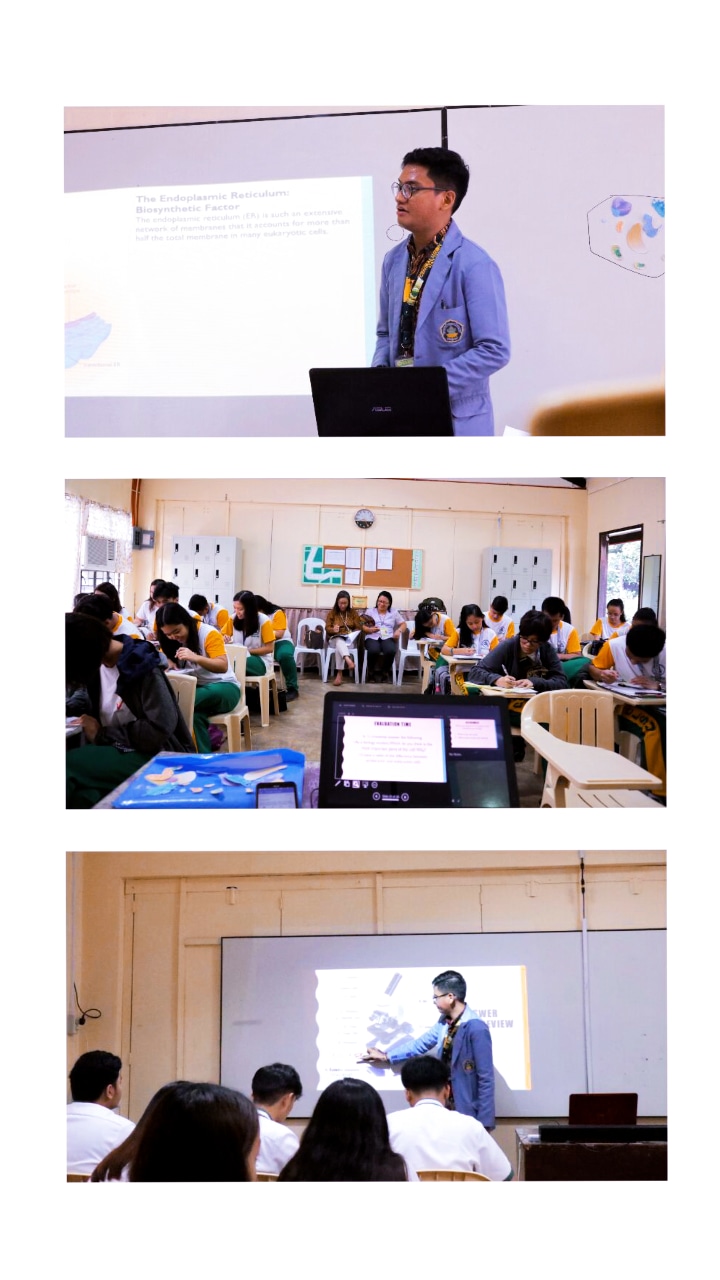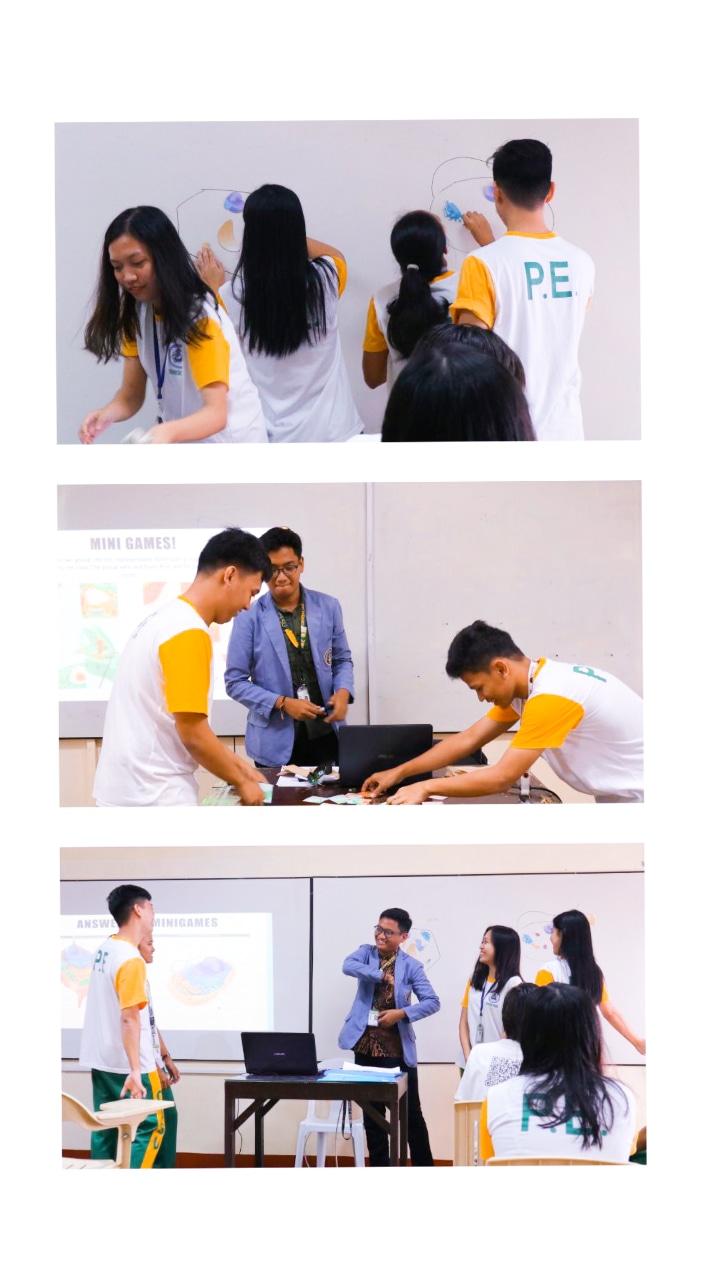Student Name: Marcel Adiwibawa
Origin University: Ganesha University of Education
Recipient University: Central Luzon State University
Recipient School: University Science High School
Let Me Introduce Myself

Hello, my name is Marcel Adiwibawa, one of the students from the Biology Education department, Ganesha university of education (Undiksha). At present, I live in one of the provinces that are already well-known all over the world which has the nickname “Island of the Gods” which is Bali. This time, I will tell my story together with my friends from Undiksha who have been selected in participating in the University to University Program (U to U Programme) for one month that has been designed by LP3M Undiksha, which is the Overseas Field Experience Program (PPL-LN). The country that became my destination in implementing the overseas program was the Philippines.
The first thing on my mind is that the Philippines is a unique place and certainly has a culture and geography that is similar to Indonesia and is very fun to explore. But what I will do there is something bigger than just exploring and carrying out vacations, but what we will do there is teach students who have different nationalities, traits, and behaviors when compared to things in our country. Actually, I am a little nervous to continue to follow this program because when I see the ability to speak using fluent English, I belong to the type of person who is able to communicate fluently when using English. However, I still made up my mind, because with the courage to get out of the comfort zone, someday we will get extraordinary experience and certainly will not be forgotten.
My First Impression in the Philippines
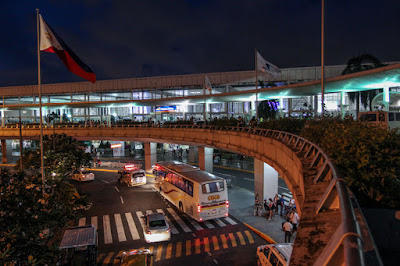 We arrived in the Philippines around 3 am on the 20th of August 2019. At that time, the sky was still dark, but I was able to see the hustle and bustle of Manila which continued to be active for 24 hours like Jakarta. In the Philippines, they use the Tagalog Language as their main language and English as their second language. The thing that makes it not hard for us to talk with people who are here.
We arrived in the Philippines around 3 am on the 20th of August 2019. At that time, the sky was still dark, but I was able to see the hustle and bustle of Manila which continued to be active for 24 hours like Jakarta. In the Philippines, they use the Tagalog Language as their main language and English as their second language. The thing that makes it not hard for us to talk with people who are here.
The next trip after we arrived at NAIA Airport was towards the campus which would be our home for 1 month, the Central Luzon State University, located in the city of Munoz, Nueva Ecija. The location of this campus is in the center of the island of Luzon so the distance we have to travel to get there is about 4 hours drive.
During the trip, I kept my eyes open to see how the scenery was in the Philippines in the morning. Apparently, the scenery that we saw was almost similar to the scenery in Indonesia. We found a vast expanse of rice fields, people passed by Lalang in a market located on the edge of the road and buildings similar to those in Indonesia.
On our trip too, we took time to talk with Mr. Joel, our companion during his stay in the Philippines about a little culture and language in the Philippines and it turns out our culture and language are almost similar to those in Indonesia. We also took time to joke with each other with Mr. Joel to eliminate our drowsiness during the trip to CLSU.
From the story we got from Mr. Joel, the Philippines is the country that receives the longest birth in the countries of the world, and upholds respect for older people. Philippine food also has a distinctive taste that is very appetizing for eating. The Philippines also has it’s country’s distinctive transportation, Jeepney, and Tricycle, which are very rarely found in other countries.
RSTC, Home Sweet Home!

Finally, at 9 o’clock in the morning, we all arrived in front of the CLSU main gate. My feeling at that time was very happy mixed with nervousness. Because I do not know what things I will face here later. The first thing we did when we first came to this place was to go to the RSTC Hostel where we lived during our teaching practice.
Our hostels are large enough and comfortable to live in. I got a room No. 06 which turned out to be a room with a single bed type. So that I would sleep alone later, separated from my male friend who also joined the program, Suprapta. But the room I got was quite comfortable so I was comfortable staying there.
As it turned out, we were not the only students who took part in the exchange program. We also meet friends who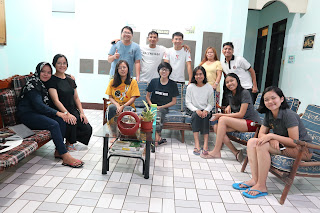 conduct study exchanges from China and Vietnam, and we also meet with our friends who are also from Indonesia who take part in the SEA Teacher and SEA Tvet programs. We met each other and now, we’re like family in here. We are also acquainted with ma’am Donallyn and all the staff who work at RSTC. They are all very kind to us and will certainly be the hardest parting we will feel when we return to Indonesia.
conduct study exchanges from China and Vietnam, and we also meet with our friends who are also from Indonesia who take part in the SEA Teacher and SEA Tvet programs. We met each other and now, we’re like family in here. We are also acquainted with ma’am Donallyn and all the staff who work at RSTC. They are all very kind to us and will certainly be the hardest parting we will feel when we return to Indonesia.
Orientation Day !!

Wednesday, August 23 th 2019 is my first orientation which was followed not only by us who came from the U to U (University to University) the program, but also was attended by all participants of the student exchange program, SEA Teacher, and also SEA Tvet. We were briefly introduced to the Filipino culture but were of great significance to us, and we received a lot of very important knowledge that we could apply later when returning to Indonesia.
We also had a chance to meet with all the important officials in CLSU, especially Mr. Regidor G. Gaboy, Dean of College of Education, As well as our prospective teacher candidates during the teaching practice at school. We ended this orientation activity by having lunch together, and when I tried for the first time a typical Filipino meal, it turned out really delicious! Very fitting on our tongue which is Indonesian citizens. Starting from there, I increasingly want to explore the foods in the Philippines.
After doing the orientation, the time is to look around what is around CLSU. CLSU is a progressive university committed itself to the nation’s march to progress by providing its students with equality education that enables them to become responsive and productive citizens of their community and of the country as a whole. This CLSU area is very wide. There are many important buildings such as the Reimers hall, USHS and DepEd building, Dormitory, Tennis Court, Botanical Garden, CTC Building, Hospital, Little Baguio park, Mini Rizal Park, and many more. On-campus there is also a shopping center for students named “Old Market” which sells equipment and food needed by all students. The food there is so delicious that I want to go on and on to go there.
University Science High School Info

1. General Information
University Science High School (USHS) is one of the schools that is part of the Central Luzon State University (CLSU) and is not part of the Philippines secondary school system. The location of this school is located in the Science City of Muñoz, Nueva Ecija, Philippines. USHS was established on June 14, 1976. For more information about USHS, you can access this information at www.ushs-clsu.edu.ph
USHS was established under Council Resolution No.1662 which was passed on June 14, 1976. The creation of the USHS school was established as a place of learning for students who wish to continue their education, especially in the fields of science and technology. Council resolution 1780 was passed a revision in 1978. The school of agricultural science, the name of USHS, opened its doors for qualified applicants and through screening with entrance examinations with only 80 slots in their first year (1978). After five years using the name, they finally changed their name to USHS. This change was made in response to the school’s intensive emphasis on technology and science and has continued for almost two decades.
USHS is currently led by Mercedita M. Reyes as its school principal. This school covers junior and senior high school education. In 2019-2020, there were 320 junior high school students and 119 high school students, so that the total number of students attending USHS was 439 students.
1.2 Vision and Mision

A. Vision
The University Science High School aims to be at par with secondary science institutions in the Asia-Pacific region.
B. Mission
To develop students who are highly competitive in Math, Science and Technology, and Communication (Asia-Pacific region).
C. Philosophy
The school believes that education is the prime instrument of national development and the key to excellence and global competitiveness.
D.Objectives
- To develop student’s scientific attitude, analytical and critical thinking, creativity and innovative abilities, mathematical and communication skills.
- To develop student’s well-rounded personality-physically, emotionally, socially, spiritually, and culturally prepared to live independently in their highly competitive world.
Academic Support System
Facilities at university science high school are very adequate. Each classroom has air conditioners, fans, projector, other rooms have LCD TV and outside the room with CCTV cameras to improve school security and monitor student activities while in school. In addition the school library is very convenient and provides a very good reference book. Not only that teachers all also provided equipment such as computers, printers, internet networks and loudspeakers to facilitate and accelerate the performance of teachers in carrying out their duties.
Here is the list of classroom and the number of students per level:
Junior High School
| Grade Level |
Number Of Students Per Level |
Section |
Male |
Female |
Total |
| 7 |
90 |
7-Adventures |
15 |
30 |
45 |
| 7-Explorers |
15 |
30 |
45 |
| 8 |
79 |
8-Inventors |
10 |
30 |
40 |
| 8-Researchers |
11 |
28 |
39 |
| 9 |
79 |
9- Examiners |
14 |
25 |
39 |
| 9- Discoverers |
16 |
24 |
40 |
| 10 |
72 |
10- Achievers |
14 |
22 |
36 |
| 10- Innovators |
14 |
22 |
36 |
| Total |
320 |
|
109 |
211 |
320 |
Senior High School
| Grade Level |
Number of Students Per Level |
Section |
Male |
Female |
Total |
| 11 |
64 |
11-Originators |
14 |
19 |
33 |
|
|
11-Voyagers |
15 |
17 |
32 |
| 12 |
54 |
12-Navigators |
8 |
19 |
25 |
|
|
12-Developers |
7 |
20 |
27 |
| Total |
118 |
|
44 |
75 |
119 |
Summary :
Junior High School: 320 students
Senior High School: 119 students
Total Population: 439 students
Teaching System
The teaching system in this school, teachers will be given one-hour teaching for one class per day. Teachers can use books, PowerPoint or handouts that can allow students to learn the material first before they arrive at school. Teachers will teach with various learning models according to the topic being studied.
The school is held for 5 days and it starts at 07.30 and ends at 17.00. Every grade has a different subject. Here is the list of subject each grade :
| Grade |
Subjects |
| Grade 7 |
Science, Filipino, EsP, Research, Math, TECH SKILL, English, Homeroom, Music, Health, AP, PE, ARTS. |
| Grade 8 |
EsP, Science, English, Filipino, AP, JPES, Health, Homeroom, Music, Research, Envie, ARTS, Math, FL, PE. |
| Grade 9 |
English, Math, AP, Advance Algebra, Research, Biology, Filipino, Music, Homeroom, EsP, Health, Chemistry, Nihongo, ARTS, PE, Physics. |
| Grade 10 |
Physics, Health, Music, English, Biology, Math, Homeroom, EsP, Research, Filipino, PE, ARTS, Tech Skill, AP, Chemistry. |
| Grade 11 |
Komunikasyon at Pananalistik, Gen Math, ICT, Oral Com, Gen. Chem, Homeroom, Pre Cal, Earth Sci, Intro to Philosophy, PE & Health. |
| Grade 12 |
Biology, Personal Dev’t, English for Acad & Prof Purposes, Filipino sa Piring Larangan, Homeroom, 21st Century Lit, Gen Physics, Practical Research, PE & Health. |
Materials and Other Learning Sources
For the materials, the teachers in CLSU Science High School that used English but still mixed with the Tagalog Language. To provide a learning process in the classroom, teacher use course syllabus, internet (Book Online) and textbook, lecture notes/ handout, and PowerPoint presentation. My cooperating teacher (Sir Marius) always give a handout to the student at the end of the topic, so the student can learn more at the home because the teacher will give a quiz before they are moved to the next topics.
Measurement and Evaluation System
This school has different measurement and evaluation system with another school in my country, Indonesia. Learners from Grades 1 to 12 are graded on Written Work, Performance Tasks, and Quarterly Assessment every quarter. Written Work, Performance Tasks and Quarterly Assessment every quarter are given specific percentage weights that vary according to the nature of the learning area.
USHS also has several extracurricular to improve the students’ soft skill such as;
- Philatelists Club led by Asst. Prof. Emily A.
- Debate Society led by Asst. Prof. Cynthia Lyn P. Curada.
- SMFILMEKK or Samahan ng mga Mag- aaral sa Filipino, Musika, Ekonomika, Kultura at kasayangan led by Mr. Mark Christian V. De Jesus.
- MEC or Math Enthusiasts’ Circle that led by Ms. Joanne S. Dizon.
- SSC or Seekers’ Science Club led by Assoc. Prof. Evelyn M. Ben.
- SBO or Students Body Organization led by Asst. Prof Allan F. Antalan.
- YES-O
- Cultural Group
- The Researchers
Pedagogical Contents
2.1. Teaching Method

In preparing the learning process in class, a teacher must be able to prepare various things related to the methods, strategies, and teaching techniques that are summarized in a lesson plan. A teacher is required to have their own style in the learning process so that the classroom atmosphere does not become monotonous which can lead to the failure of students in receiving the material provided.
Based on the lesson plans that have long been implemented at USHS, there are three main parts that must be present in each learning process, namely, introduction, main activities, and pre activities. In the introduction, the teacher focuses on ways to initiate learning or introduce new lessons to students in the class. Furthermore, the teacher will carry out a motivational phase that aims to enable students to think critically and provide lessons to be learned later in the student’s real life.
Next is entering the main activity where the teacher will explain the material supported by learning media as well as learning resources in accordance with the material being taught. And in the pre/closing activities, the teacher will conclude the whole material and check student understanding by giving assignments or homework.
For learning in 12th-grade general biology subjects, teachers usually apply 5 stages, namely, recall, motivation, application, generalization, and evaluation. The recall is intended to activate students regarding their understanding of previous learning material. Motivation is intended to enable students to be ready to receive the learning material to be taught. Application is the stage where students receive knowledge given by the teacher. Generalization is the stage of concentration of the material being taught to students. And finally, the evaluation is the stage to test students’ understanding of the material being taught.
2.2. Learning Materials and Innovations
To expedite the learning process, a teacher is required to use a variety of learning materials and apply different techniques and methods, according to the topic of ongoing learning. By using appropriate learning techniques and methods, students will more easily grasp the lesson and its explanation. Innovation is an important point that must be upheld by every teacher because by providing innovations such as the formation of study groups, giving minigames related to the learning process will be able to increase student interest in following the learning process in class.
2.3. Learning and technology resources
Currently, teachers are made easy in finding interactive learning resources that can be obtained from the internet or books that are easily found in libraries and elsewhere. In the 21st century today, teachers are also required to be able to use technology that is able to support the teaching process.
2.4. Authentic Assessment
Authentic assessment is the stage in evaluating students of their ability to apply the knowledge they find during the learning process in class. Students will be evaluated in the form of assignments or homework. This evaluation process will be generalized at their respective grade levels. At USHS, evaluations are usually given in the form of simple understanding questions related to the learning that has been taught. There are three criteria for assessment according to the Department of Education Philippines, namely tertiary work (30%), performance tasks (50%), and quarterly assessments (20%).
My General Biology 1 Teaching Plan!
University Science Highschool (USHS) and almost all schools in the Philippines use the K-12 curriculum that is regulated in-laws and regulations made by the Department of Education (DepEd) of the Philippines which is the core of this curriculum is student-centered learning.
this is a curriculum syllabus and my lesson plan for 12th-grade students specifically on General Biology 1 subjects that look like in the following:
Teaching Practice
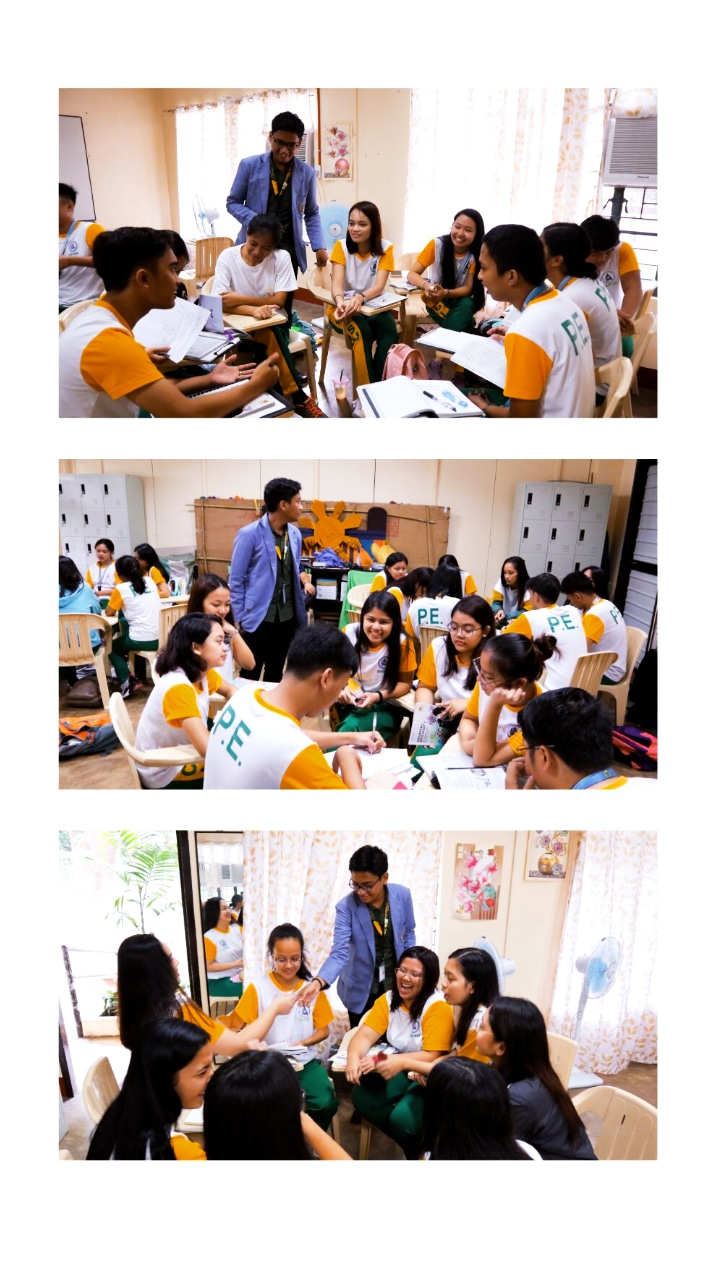
My Summary and Suggestions


5.1. Purpose of the teaching practice
The purpose of teaching practicum is to provide teaching and teaching for prospective teachers by participating in teaching practices abroad in the hope of preparing professional and competent teachers both at national and international levels, especially in ASEAN countries.
5.2 Results of Practice
Participating in the practice teaching program in the Philippines is a matter of pride for me because in this program I get a lot of new things about how to be a good teacher, how to manage classes, how to communicate with outsiders, and of course being able to recognize foreign cultures which are certainly different from cultures we are Indonesian.
The knowledge that I gained in the Philippines will later be put into practice in my work life later in Indonesia and I will share my unforgettable experiences which will certainly foster the confidence of my next generation who later will also participate in this activity. and later what I have gotten will be able to boast of my alma mater, Undiksha and of course the country that I love, Indonesia.
5.3 Challenges of the Practice
My biggest challenge during the program was my nervousness. however, I still have to be confident because it is my self-confidence that can improve the quality of our self so as to create memories that will not be forgotten and finally be able to give my best during the teaching and teaching activities here.
5.4 Overall Impression
The teaching practice especially in another country is an interesting program and challenging at the same time. For me, by joining this program I can get new experience and also memory and add it to my mind as new precious knowledge. And of course, I found my little family here, both at RSTC and at school. although our meeting was only brief, the memory that was created together with them I will never be able to forget forever.
5.5 Suggestion for Future Improvement
For the next candidate of teaching practice abroad please make yourself well because it is not easy like what you thought because of different culture and mindset. Beside that, you will learn the education system here in which different from your own country. Also, you need to be able to adjust your food here because the taste of some food is different from your own country. Next, you need to be able to socialize with people; partners, teachers, staff in the school, students, and society. For the last is a team working is very useful here.


 We arrived in the Philippines around 3 am on the 20th of August 2019. At that time, the sky was still dark, but I was able to see the hustle and bustle of Manila which continued to be active for 24 hours like Jakarta. In the Philippines, they use the Tagalog Language as their main language and English as their second language. The thing that makes it not hard for us to talk with people who are here.
We arrived in the Philippines around 3 am on the 20th of August 2019. At that time, the sky was still dark, but I was able to see the hustle and bustle of Manila which continued to be active for 24 hours like Jakarta. In the Philippines, they use the Tagalog Language as their main language and English as their second language. The thing that makes it not hard for us to talk with people who are here.
